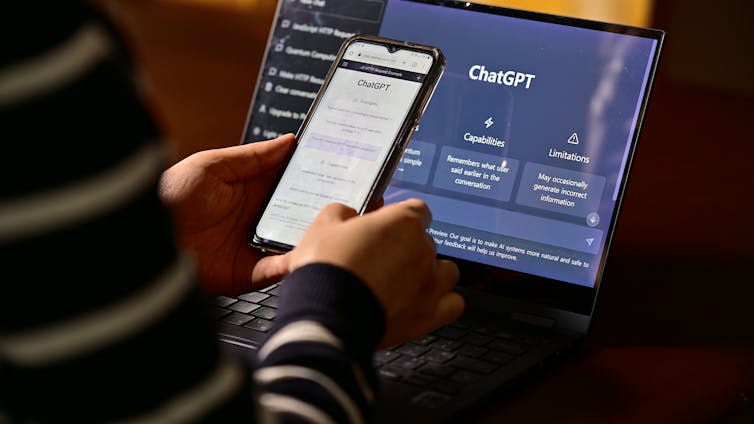This article contains spoilers for We Solve Murders.
We Solve Murders is the latest crime novel from Richard Osman, bestselling author of The Thursday Murder Club series. The story follows Amy Wheeler, a bodyguard for the security firm Maximum Impact, and her father-in-law, Steve Wheeler, a former London detective now handling small-town investigations in rural England.
Amy’s latest assignment is to protect Rosie D’Antonio, the world’s most famous author (“if you don’t count Lee Child”). However, what begins as a routine assignment takes a dangerous turn when Amy becomes the target of François Loubet, a dangerous criminal picking off the associates of Maximum Impact.
François pulls the strings of his operation from afar via email. He uses a unique communication method which involves running his messages through ChatGPT with the prompt: “ChatGPT, rewrite in the style of a friendly English gentleman, please.”
As a result, his messages – whether they be to Maximum Impact’s CEO, or his own hitmen – adopt a distinctive linguistic style, marked by old-fashioned adjectives (“jolly”, “marvellous”, “blasted”), nouns (“luncheon”), address terms (“old bean”) and sign-offs (“tally-ho”). Together, these features evoke at least a parody of the elderly, well-to-do gentleman that François seems to be aiming for.
Luckily, other characters immediately recognise the potential for linguistic traits to offer clues to François’ real identity: “Who is this man? There must be something that gives him away – a turn of phrase, anything?” Whether consciously or not, they are beginning to venture into the world of authorship analysis.
Authorship analysis in the real world
Authorship analysis involves attributing linguistic patterns to specific authors through the analysis of linguistic features including vocabulary, syntax and stylistic choices.

This task is of great value to criminal investigations that involve anonymous or disputed authorship and forms a core component of the field of forensic linguistics.
When faced with a text of unknown authorship, forensic linguists are typically tasked with one of two versions of the problem:
- Who wrote this text? (authorship attribution)
- What kind of person wrote this text? (authorship profiling).
A notable case is that of the Unabomber, Ted Kaczynski, whose manifesto was analysed and compared to his personal letters, which revealed a set of unique stylistic choices that were found to be consistent in both.
These methods have also informed evidence in murder cases such as those of Amanda Birks and Debbie Starbuck. In both cases, linguistic analysis suggested that text messages and emails apparently sent by the victim were actually authored by their killers (in both cases their husbands) in order to mislead friends, family and the police.
We don’t yet know the extent to which criminals are using ChatGPT and other large language models (LLMs) as a means of disguising their linguistic style. However, researchers are increasingly reporting on the various misuses of these technologies, from academic plagiarism to the spread of misinformation and creation of malware and fraud. There is no doubt among law enforcement and cybersecurity experts that LLM-assisted crime is a growing threat.
The challenge posed by ChatGPT
Fraud is one criminal domain in which we can already see LLMs providing linguistic assistance, for example in the construction of phishing emails. Thanks to this technology, they are increasingly personalised and devoid of the spelling and grammatical mistakes that once provided useful red flags.
LLMs are beginning to disrupt countermeasures to criminal activity and create new challenges for authorship analysis in the future. The good news is, that as LLMs are increasingly put to malicious uses, researchers are harnessing the same technologies in the fight against crime including scam detection and countering hate speech online.

Authorship analysis experts now face a third fundamental question to add to the previous two: Did a person write this text?
As the use of LLMs further complicates authorship analysis, we are seemingly on the cusp of a shift towards new methods and approaches. One such complication is the likelihood that those using ChatGPT and similar tools to obscure their linguistic style will not stop at a straightforward “translation” of their message, as François does in Osman’s novel. Instead they will edit, tweak and extend the resulting communication to the point that we would consider it to be of hybrid authorship, containing style markers from both the LLM and the individual.
While this scenario is more complex for the analyst, it also offers an opportunity, in that some evidence of the author’s style will remain and can be used to aid identification. Let’s hope the likes of François realise that, despite increasingly sophisticated tools, linguistic disguise will always be imperfect. Where criminal cases do involve a linguistic element, language analysis typically forms a small part of a far bigger evidentiary picture.
![]()
The authors do not work for, consult, own shares in or receive funding from any company or organisation that would benefit from this article, and have disclosed no relevant affiliations beyond their academic appointment.



